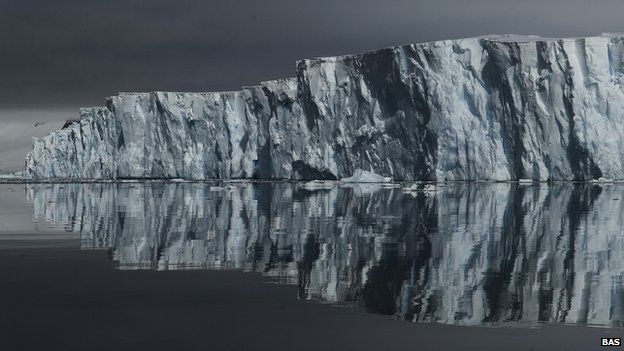Antarctic coastal waters 'rising faster'
- Published

Melting ice is fuelling sea-level rise around the coast of Antarctica, a new report in Nature Geoscience finds.
Near-shore waters went up by about 2mm per year more than the general trend for the Southern Ocean as a whole in the period between 1992 and 2011.
Scientists say the melting of glaciers and the thinning of ice shelves are dumping 350 billion tonnes of additional water into the sea annually.
This influx is warming and freshening the ocean, pushing up its surface.
"Freshwater is less dense than salt water and so in regions where an excess of freshwater has accumulated we expect a localised rise in sea level," explained Dr Craig Rye from the University of Southampton, UK, and lead author on the new journal paper.
Globally, sea levels are going up, in part because of the contribution of the world's diminishing ice fields. This is well known.
But the Nature Geoscience report is the first to show the direct consequences to sea surface height (SSH) around Antarctica itself.
While the satellite data record indicates there has been a general upward trend in SSH in the Southern Ocean south of 50 degrees of up to 2.4mm per year, those satellites also indicate a more rapid rise in waters sitting on the continental shelf.
Mass losses
Modelling by Dr Rye's team suggests that this additional 2mm per year can be attributed almost exclusively to freshwater runoff from Antarctica, and not to some climatic oscillation that might make sea levels "breathe" up and down on decadal timescales.
"We can estimate the amount of water that wind is pushing on to the continental shelf, and show with some certainty that it is very unlikely that this wind forcing is causing the sea level rise," Dr Rye told BBC News.
"And because we can model the freshwater forcing, and the fact that this is so much more like what we see in the real world, we can come to the confident conclusion that the signal is driven by freshwater forcing."
Recent satellite studies have underlined the increased mass losses occurring in Antarctica.
Much of this accelerated ice discharge is occurring in the continent's western sectors, particularly in the Amundsen Sea Embayment and along the Antarctic Peninsula.
In contrast to land ice, the sea ice around Antarctica stands at record levels and is becoming more extensive.
The growth is small and very regional in character, but nonetheless significant.
Quite how the freshening of surface waters might be influencing this phenomenon is now a target for study.
"That's a really interesting question which I'd like to look into with further research," Dr Rye said.
Jonathan.Amos-INTERNET@bbc.co.uk and follow me on Twitter: @BBCAmos
- Published19 May 2014
- Published16 June 2014
- Published29 November 2012
- Published24 September 2012
- Published23 July 2014
- Published20 August 2014